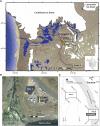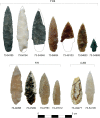Dating of a large tool assemblage at the Cooper's Ferry site (Idaho, USA) to ~15,785 cal yr B.P. extends the age of stemmed points in the Americas
- PMID: 36563150
- PMCID: PMC9788777
- DOI: 10.1126/sciadv.ade1248
Dating of a large tool assemblage at the Cooper's Ferry site (Idaho, USA) to ~15,785 cal yr B.P. extends the age of stemmed points in the Americas
Abstract
The timing and character of the Pleistocene peopling of the Americas are measured by the discovery of unequivocal artifacts from well-dated contexts. We report the discovery of a well-dated artifact assemblage containing 14 stemmed projectile points from the Cooper's Ferry site in western North America, dating to ~16,000 years ago. These stemmed points are several thousand years older than Clovis fluted points (~13,000 cal yr B.P.) and are ~2300 years older than stemmed points found previously at the site. These points date to the end of Marine Isotope Stage 2 when glaciers had closed off an interior land route into the Americas. This assemblage includes an array of stemmed projectile points that resemble pre-Jomon Late Upper Paleolithic tools from the northwestern Pacific Rim dating to ~20,000 to 19,000 years ago, leading us to hypothesize that some of the first technological traditions in the Americas may have originated in the region.
Figures






References
-
- L. G. Davis, D. B. Madsen, L. Becerra-Valdivia, T. Higham, D. A. Sisson, S. M. Skinner, D. Stueber, A. J. Nyers, A. Keen-Zebert, C. Neudorf, M. Cheyney, M. Izuho, F. Iizuka, S. R. Burns, C. W. Epps, S. C. Willis, I. Buvit,Late upper paleolithic occupation at Cooper’s Ferry, Idaho, USA, ~16,000 years ago. Science 365,891–897 (2019). - PubMed
-
- JD Lancaster “Progress in the search for early sites in the lower Salmon River canyon, Idaho: A case study in geoarchaeological prospection,” thesis, Oregon State University, Corvallis (2015).
-
- L. G. Davis, K. Muehlenbachs, C. E. Schweger, N. W. Rutter,Differential response of vegetation to postglacial climate in the lower Salmon River canyon, Idaho. Palaeogeogr. Palaeoclimatol. Palaeoecol. 185,339–354 (2002).
-
- L. G. Davis “The coevolution of early hunter-gatherer culture and riparian ecosystems in the southern Columbia River Plateau,” thesis, University of Alberta, Edmonton (2001).
-
- S. J. Fiedel, B. A. Potter, J. E. Morrow, M. K. Faught, C. Vance Haynes Jr., J. C. Chatters, Pioneers from Northern Japan in Idaho 16,000 Years Ago? A Critical Evaluation of the Evidence from Cooper’s Ferry. PaleoAm. 7, 28–42 (2020).
LinkOut - more resources
Full Text Sources

